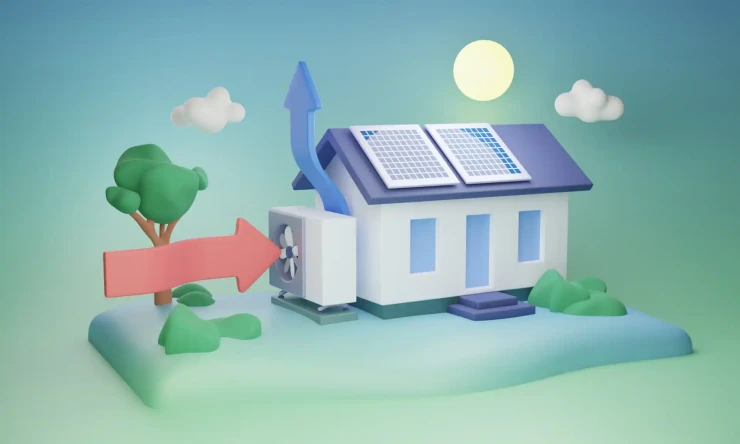New advances in solar panel technology are announced constantly. There were many breakthroughs in 2019 with milestones being reached in solar efficiency, solar energy storage, wearable solar tech, and solar design tech.
The two main types of solar technology are photovoltaics (PV) and concentrated solar power (CSP). Solar PV technology captures sunlight to generate electric power, and CSP harnesses the sun’s heat and uses it to generate thermal energy that powers heaters or turbines. There is a wide range of opportunities for technical innovation with these two forms of solar energy. One of the latest emerging developments in solar power technology to come out of 2019 involves a new form of combined solar power generation and storage.
This new form of integrated solar power generation and storage is currently being developed for the UK.
It pairs thin, flexible, lighter solar sheets with energy storage to power buildings or charge vehicles off-grid.
Solivus, the company behind the development intends to cover the roofs of large industrial buildings with the solar material. These buildings would include supermarket warehouses and delivery company distribution centres.
COMPARE PRICES FROM LOCAL INSTALLERS
Compare prices from local companies fast & free
Enter your postcode to compare quotes from leading professionals. We promise to keep your information Safe & Secure. Privacy Policy
They also plan to manufacture solar units or "arcs" for home usage.
The aim is to develop regional, renewable energy to allow people and businesses to have their very own power supply as well as helping the UK reach its target of net zero greenhouse gas emissions by 2050.
The solar product is a carbon-based sheet, which Solivus describes as an "organic photovoltaic" (OPV). It’s a material that absorbs sunlight and creates energy.
The layered film can be used on surfaces where panels can’t be used or fixed on, without harming the integrity of a building because it not only can be bent into shapes or glued on to flat or curved, vertical or horizontal, surfaces but is also one-tenth of the weight of typical panels in frames at 1.8kg per m2. The material also doesn’t contain any rare earth or toxic materials and lasts for 20 years.
Solivus places the material’s effectiveness in a laboratory at about 13% but states that this stays steady as temperature levels increase in natural sunlight. This can be a problem with traditional solar panels although they can function at an average of 15-18% efficiency.
Manufacturer Heliatek says the film collects a wider spectrum of light while still working on grey days.
The plan is that the power generated will be stored locally, in an electric vehicle battery, or possibly a flywheel battery, which can swiftly release its charge.
The story behind this development is that Jo Parker-Swift who has a background in biological sciences was inspired to create the new material when looking at laurel leaves. However, it was a fortuitous meeting on a train with two former energy company bosses and a discussion about growing demand that motivated her to think about a way to take her house and car off grid.
It was then that she looked at the leaves on the laurel bush in her garden and began to calculate the surface area. She said “I must have looked like a right nutter” as she marked all the leaves, so she didn’t count them twice.
She felt that nature might have the answer to energy independence by using a large surface area in a small space, to capture sunlight. She was thinking along the lines of a solar tree.
She then commenced two-and a-half years of research with financial investment to develop the idea that it would not just be one house running off-grid, but also business, delivery companies and their vehicles, homes, stadiums, and energy points to charge electric transport.
Currently, transport accounts for 23% of the UK's CO2 emissions, and the government has pledged to ending the sale of new petrol or diesel vehicles by 2040.
Jo Parker-Swift hopes the film will assist in the battle to stop levels of carbon dioxide increasing in the atmosphere and the damage to progressively acidic oceans.
Businesses keen to be carbon neutral have responded positively and Solivus’s medium-term strategy is to roll out an installation of film on large UK commercial properties and stadiums in 2021/22
Solivus expects that a 10,000m2 roof will provide approximately 1MW of energy which is about enough to power a block of flats.
The company is also working with the University of Manchester's Graphene Engineering Innovation Centre to see if graphene can be used in the production of the new material.
Graphene is a strong 2D material just one atom thick, which conducts heat and electricity efficiently.
The next step is to install the solar fabric on a large building such as a farm or industrial building. The film is shaped into “arcs” which are units with curved sides and a large surface area designed to absorb more light without needing to track the sun.
It is anticipated that one unit would be a 1 kW system providing 1,000 KWh (kilowatt hours) each year in the UK. The university of Surrey researchers are looking at the public response to the idea and the design.
The aim would be to keep the cost to consumers below current energy bills.
Professor Michael Walls, of the Centre for Renewable Energy Systems Technology at Loughborough University, says the concept of lightweight PV on buildings is "exciting" because it creates new applications for solar. There are however some economic and practical hurdles.
At the moment, there is a much larger market for traditional rigid solar panels which means that manufacturers of flexible PV do not have the same economies of scale.
The most dominant technology used in flexible PVs up to now has been CIGS which are devices made up of copper indium gallium diselenide.
Professor Michael Walls, says that so far, problems have been experienced with some flexible solar films where water has seeped through the coating, eventually causing degradation.
He says:
“If they can sell at a reasonable cost and avoid technical issues, it would be fantastic, but there are many challenges”.
Although we do not yet have a solar tree the journey towards this goal is still in progress.
Find out more about solar here.





























